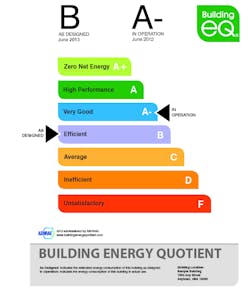ASHRAE’s Building Energy Quotient (bEQ) program now includes a second label for rating a building’s energy use.
The program’s “In Operation” label rates actual measured energy consumption as influenced by a building’s occupancy and usage, while the new “As Designed” label rates potential energy consumption under standardized conditions independent of a building’s occupancy and usage.
The As Designed label is based on a comparison of simulated energy use to a baseline median energy-use intensity. It is said to be a useful tool for tenants who want to compare buildings without the effects of current occupants as well as for operators who want to know whether a building’s potential is being met. For an As Designed rating to be received, a standardized energy model must be performed by an ASHRAE-certified building-energy-modeling professional (BEMP).
The In Operation label is based on a building’s actual energy use over the preceding 12 to 18 months. Key components are an ASHRAE Level I Energy Audit conducted by an ASHRAE-certified building-energy-assessment professional (BEAP) and recommendations for energy improvement. It is intended to help building owners and operators see how their building’s energy use compares to the energy use of a median baseline building and highlight the building’s potential for energy-performance improvement.
“BEQ is a voluntary program that draws on successful features from other U.S. and European building-labeling and certification programs,” Amy Musser, PhD, PE, a consulting engineer in Asheville, N.C., and volunteer chair of the bEQ committee, said. “Building energy-use disclosure is already mandatory in the states of California and Washington; the cities of Washington, D.C.; Austin, Texas; Boston, Mass.; Philadelphia; Pa.; New York City, N.Y.; San Francisco, Calif.; and the European Union and Australia.”
Building owners who participate in the program receive a displayable plaque, a dashboard providing a quick overview of energy use, and a certificate that can be used to satisfy state and local disclosure requirements.
Buildings can be rated using both labels or just one.
For more information, visit www.buildingenergyquotient.org.
About the Author
Scott Arnold
Executive Editor
Described by a colleague as "a cyborg ... requir(ing) virtually no sleep, no time off, and bland nourishment that can be consumed while at his desk" who was sent "back from the future not to terminate anyone, but with the prime directive 'to edit dry technical copy' in order to save the world at a later date," Scott Arnold joined the editorial staff of HPAC Engineering in 1999. Prior to that, he worked as an editor for daily newspapers and a specialty-publications company. He has a bachelor's degree in journalism from Kent State University.

